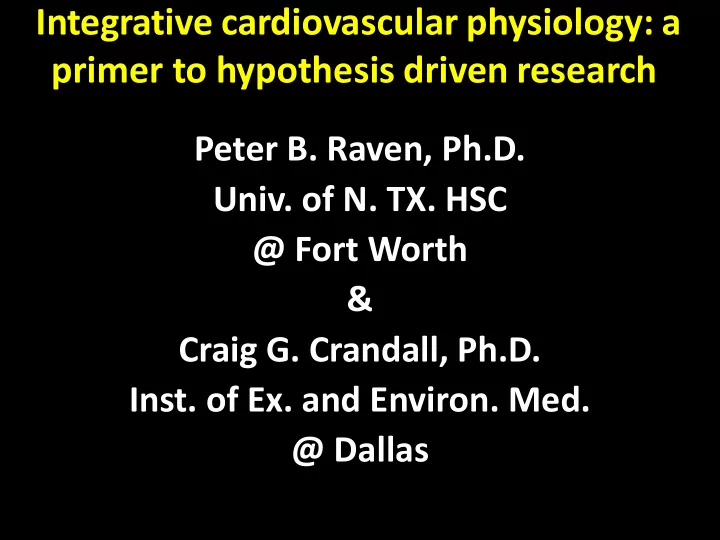

Integrative cardiovascular physiology: a primer to hypothesis driven research Peter B. Raven, Ph.D. Univ. of N. TX. HSC @ Fort Worth & Craig G. Crandall, Ph.D. Inst. of Ex. and Environ. Med. @ Dallas
Founded 1264 Founded 1474 Founded 1636 August Krogh Inst. 1970- University Laboratory of Harvard Fatigue CMRC 1994-2003 Physiology-1882- Laboratory 1927 – 1946 CIM 2005-
History of Exercise Physiology U of Copenhagen 1864 Bohr Effect Physiology Laboratory Father of Niels Bohr Atomic Theory & Quantum Mech. 1820-1885 1855-1911 Peter Ludvig Panum Christian Bohr August Krogh 1874-1949 Karl A. Hasselbach 1874-1962 Lawrence J Henderson Founder Harvard 1878-1942 Fatigue Lab 1927 Dir. David B. Dill
Start of Exercise Physiology Student of C. Bohr Johannes Lindhard, MD 1870-1947 Zoophysiologist, D.Sc. Equipment Inventor Student of Hasselbach Interest in Exercise 1920 Nobel Prize for Theory of Gymnastics Capillary Recruitment 1874-1949 August Krogh 1909 U of Copenhagen Laboratory of Gymnastics Erik Howhu-Christensen Erling Assmussen Marius Neilsen 1904-1996 1907-1991 1903-2000 The Three Musketeers
Translation and Integration
Identify a Question • Background Literature 1. - 1. -Self or Mentor directed 2. -Epidemiology 3. -Previous Investigations often raise questions How?, Why? 4. -has it been addressed before? 5. -If it has been addressed, do you agree? e.g.? Blood vessel recruitment in contracting muscle-1920 Nobel Prize-August Krogh ? Heart Rate increasing from rest during dynamic exercise (Rowell)
Old thinking vs Current thinking
Develop a Hypothesis • A Hypothesis is a proposed explanation for an observable phenomenon (finding); • Statisticians prefer “Null Hypotheses” • I prefer directed hypotheses i.e. will cause, results in, is mediated by, plays a pivotal role in, etc • The hypothesis must be testable by the research team
Background literature Previous data from lab. New published findings Multiple inputs used to Construct testable statement Results analyzed and Hypothesis tested by Hypothesis either experiments Supported or rejected
Mechanisms of Exercise-Induced Cardioprotection Scott K. Powers et al. Physiology 19: 27 – 38, 2014 • Coronary Artery Disease (CAD) major cause of death worldwide • Directly associated with Ischemia-reperfusion (IR) injury • Human and Animals studies indicate that endurance exercise training provides robust cardioprotection from IR injury • Three stages of IR injury, Arrythmia, Stunning and Cell Death
Duration of ischemia related to IR injury
Myocardial injury • Arrhythmias — Ventricular tachycardia/ fibrillation • Stunning – impaired contractility in the absence of cell death • Myocyte death – apoptosis and necrosis
Question What are the cellular events leading to IR-Induced cardiac injury ?
Cellular events leading to ischemia-reperfusion injury in the heart
Exercise Promotes Cardioprotection • Phase 1 – acquired rapidly (30 min), lost rapidly within 3 hours – activation of SOD2 located within the mitochondria • Phase 2 – 24hrs after exercise persists for 9 days after a 5-day training period in rats
Endurance exercise protects against IR injury
What Mediator(s) are responsible for exercise-induced cardioprotection
How and what cellular mechanisms are involved? 1. Exercise-Induced Changes in Coronary Circulation -- not required 2. Energy production during ischemia switches from CHO to FFA – no direct evidence links exercise training to glycolytic flux changes cardioprotection 3. NO signaling is involved in exercise induced cardioprotection
How and what cellular mechanisms are involved? (cont.) 4. Elevated Myocardial Heat Shock Proteins Are Not Essential for Exercise-Induced Cardioprotection 5. Increased Myocardial Cyclooxygenase-2 is not Responsible for Exercise-Induced Cardioprotection 6. Elevated Endoplasmic Reticulum Stress Proteins do not Contribute to Exercise-Mediated Cardioprotection
Probable cellular mechanisms involved in cardioprotection • Sarcolemmal and/or Mitochondrial ATP- Sensitive Potassium Channels • Increased Cytosolic Antioxidant Capacity • Exercise-Induced Alterations in Mitochondrial Proteins and Phenotype Are Central to Exercise-Induced Cardioprotection (drug development)
Summary of several exercise-induced cardioprotective mechanisms
Recommend
More recommend